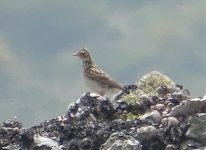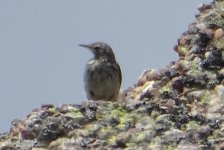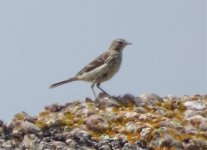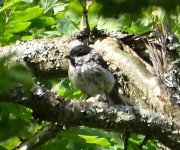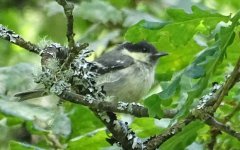-
Welcome to BirdForum, the internet's largest birding community with thousands of members from all over the world. The forums are dedicated to wild birds, birding, binoculars and equipment and all that goes with it.
Please register for an account to take part in the discussions in the forum, post your pictures in the gallery and more.
You are using an out of date browser. It may not display this or other websites correctly.
You should upgrade or use an alternative browser.
You should upgrade or use an alternative browser.
Confirmation. Mountains in Northern Spain (1 Viewer)
- Thread starter testoduro
- Start date
More options
Who Replied?PYRTLE
Old Berkshire Boy

I agree 1-4
5 is a juv great tit...
No. 5 is a Coal Tit for me.
Deb Burhinus
Used to be well known! 😎

No. 5 is a Coal Tit for me.
indeed
Danielibero
Well-known member
Is the fourth a Marsh Tit with that black around the cheek??
Alexander Stöhr
Well-known member
No,
its a 1CY Coal Tit, as allready mentioned by PYRTLE and Deb Burhinus. Please note: two whitish wingbars and just visible white patch on rear crown. Yellowish hues on cheeks are regular/normal for juvenile Coal Tits, as is head pattern of this bird
its a 1CY Coal Tit, as allready mentioned by PYRTLE and Deb Burhinus. Please note: two whitish wingbars and just visible white patch on rear crown. Yellowish hues on cheeks are regular/normal for juvenile Coal Tits, as is head pattern of this bird
Deb Burhinus
Used to be well known! 😎

Is the fourth a Marsh Tit with that black around the cheek??
#4 could be Willow Tit it’s hard to tell (even with half decent images)
Not in Spain, I think
#4 could be Willow Tit it’s hard to tell (even with half decent images)
Deb Burhinus
Used to be well known! 😎

Not in Spain, I think
Fair enough, I didnt really clock the location. Very confusing thread btw!
Last edited:
Rotherbirder
Well-known member

Why is image 1 not Thekla's Lark? Despite poor quality and partially obscured features, bill length & shape suggest that species, and isn't a conspicuous, pointed and erect crest just visible? Habitat as hinted at by OP is also better for Thekla's.
RB
RB
Danielibero
Well-known member
#4 could be Willow Tit it’s hard to tell (even with half decent images)
I meant the bird with this black around the cheek reminds me a Great Tit not a Marsh Tit... I know a Great Tit should it has a black long patch in the belly but... I am a bit confused.
Why is image 1 not Thekla's Lark? Despite poor quality and partially obscured features, bill length & shape suggest that species, and isn't a conspicuous, pointed and erect crest just visible? Habitat as hinted at by OP is also better for Thekla's.
I´m agree with this, it doesn´t seems to me a Skylark with that large bill.
Deb Burhinus
Used to be well known! 😎

I meant the bird with this black around the cheek reminds me a Great Tit not a Marsh Tit... I know a Great Tit should it has a black long patch in the belly but... I am a bit confused.
The source of the confusion is people thinking you were referring to the 5th image not the 4th one perhaps?
I understood which image you were referring to but didnt open the image(or had even noted the location, so when I commented, I assumed based on others ID, the only confusion sp was going to be a Willow Tit!) The 4th image does look like a juvenile Great Tit (with the black ‘necklace’ - I thought this initially without opening the image but gave it only a cursory glance) - However, I have doubts as the image quality is so difficult btw the black stripe is not always very pronounced on recently fledged GTs nor is the colour saturation of the mantle and belly.)
So just to clarify is there a consensus for the following?
1 Thekla’s Lark
2 Water Pipit
3 Water Pipit
4 Juvenile Great Tit
5. Juvenile Coal Tit
(I also agree the lark looks long billed and ‘pointy crested’ for a Skylark and the elevation/habitat would be perfect for Thekla)
Last edited:
Alexander Stöhr
Well-known member
The source of the confusion is people thinking you were referring to the 5th image not the 4th one perhaps?
Sorry to all, because that is what I thought. My comment nr. 6 actually related to picture nr. 5.
And I must admit that just looking at the the thumbnail of picture nr.4 I thought that the bird looked ok for a Marsh Tit, mainly because the whitish cheeks seemed to reach far to the neck, therefore producing a Jizz that was better for Marsh than for Great Tit. But after reading the other comments and looking at the fullscreen picture, I saw the black "neck-ring", so I was glad I didnt wrote a comment after only looking at the tumbnail!
And I must admit, that I thought, the lark looked ok for Skylark: I could not make a positive ID (somehow this bird looked strange, but I thought it was due to the picture quality with much "JPEG-artefacts"), but I couldnt find much against Skylark. But after reading the comment by Rotherbirder, I noticed that he seems right regarding the bill.
But as the bird seems to have a weak streaked breast (especially the centre) for a Thekla, I hope someone finds the time to write more about this picture, so I can learn.
And more: when I saw my first Theklas, I got the following feeling: their crest reminded me of an extreme Skylark. When you think, a Skylark uses hairgel to get its crest look like a Crested Lark, the result is a Thekla Lark.
This helped me many times I saw a bird in SW-France or Spain: I imagined a Skylark using hairgel to erect its crest. And if the result looked like the bird I was watching, it was a Thekla. But if I couldnt imagine that a "cool" Skylark can manage to get a crest like that, the bird was a Crested.
Thank you so much to all of you for such interesting remarks! I learn a lot with you. After digesting all the info you gave me, summing up I draw the following conclusions:
1)As for pic. 1, which was taken in Cantabria, Saja- Besaya NP, alpine meadows at 1500 mts altitude. As I said, I did hear a distinct skylark singing, then I saw pic. 1 landing. It does not seem very unlike a skylark, comparing mine with a certified one:
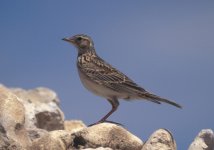
Regarding the size of the crest, skylarks can feature high crests. Comparing mine with this:
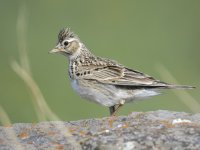
2 and 3) Water pipit
4 Juv great tit. The black collar rules out a marsh tit.
5 Coal tit. White wingbars and white patch on rear crown are telling.
1)As for pic. 1, which was taken in Cantabria, Saja- Besaya NP, alpine meadows at 1500 mts altitude. As I said, I did hear a distinct skylark singing, then I saw pic. 1 landing. It does not seem very unlike a skylark, comparing mine with a certified one:

Regarding the size of the crest, skylarks can feature high crests. Comparing mine with this:

2 and 3) Water pipit
4 Juv great tit. The black collar rules out a marsh tit.
5 Coal tit. White wingbars and white patch on rear crown are telling.
Last edited:
Users who are viewing this thread
Total: 2 (members: 0, guests: 2)




